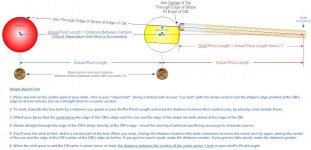Simple squirt test
This is a re-post of my Simple Squirt Test (originally posted December 2007), made even more simple and reviewed for accuracy.
The traditional "aim-and-pivot" squirt test keeps the balls at the same distance and pivots the shaft to different angles by shifting the bridge hand (pivot point) back and forth until the shot is made.
This Simple Squirt Test keeps the shaft aimed at the same two points on the CB and OB while changing the distance between the balls until the shot is made. Changing the distance between the balls while aiming at the same points on them changes the angle of the cue in (hopefully) a more controlled way that can be more accurately measured.
I hope it's helpful to you.
pj
chgo

This is a re-post of my Simple Squirt Test (originally posted December 2007), made even more simple and reviewed for accuracy.
The traditional "aim-and-pivot" squirt test keeps the balls at the same distance and pivots the shaft to different angles by shifting the bridge hand (pivot point) back and forth until the shot is made.
This Simple Squirt Test keeps the shaft aimed at the same two points on the CB and OB while changing the distance between the balls until the shot is made. Changing the distance between the balls while aiming at the same points on them changes the angle of the cue in (hopefully) a more controlled way that can be more accurately measured.
I hope it's helpful to you.
pj
chgo

Last edited: